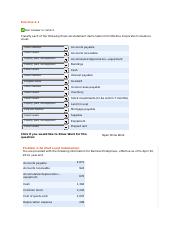Content

It’s common for high-value goods to be sent via FOB destination designation. That allows the buyer to ensure they arrive in good condition and can be inspected upon receipt. The seller retains liability until the buyer accepts the goods, ownership, and liability at the receiving dock, office or agreed-upon place of transfer, after inspecting for damage. In this type of agreement, the buyer assumes full responsibility for the goods after the seller delivers them to the https://business-accounting.net/ carrier. At the same time, even though the treadmills have not yet been delivered, the buyer has now officially taken responsibility for the goods. When at the shipping point, the buyer now has an open accounts payable balance though it also should now carry the treadmill on their financial records. The fact the the treadmills may take two weeks to arrive is irrelevant for this shipping agreement; the buyer will already possess ownership while the goods are in transit.

The seller pays for shipping, but isn’t responsible for insurance or freight. The risks transfer to the buyer only when the goods are delivered to a port of destination. FOB destination, or FOB destination point, means that the seller is at risk to pay for the damage until the buyer receives the products. The seller selects the freight carrier and is responsible for shipping the goods to the final destination point. The expansion of the global market and the rise of e-commerce has led to some interesting challenges for international shippers. As logic would denote, the further away you’re shipping your freight, the more complicated the process becomes. The transportation department of a buyer might insist on FOB shipping point terms, so that it can take complete control over the delivery of goods once they leave a supplier’s shipping dock.
The Fine Print of FOB Shipping and Destination
The term ‘pass over the rails’ was then dropped from the definitions available in the incoterm in the amendment passed in the year 2010. Define the term “contingent liability” and discuss the criteria used to classify these events or conditions. State and briefly explain three conditions which have to be satisfied before the use of the weighted average cost of capital can be justified. Describe the difference in the timing of trade execution and the certainty of trade price between market orders and limit orders. What are three main characteristics of liabilities, and why is it important to classify liabilities into short-term and long-term? Include examples of short and long-term liabilities in your response.
Thus, the sale is recorded when the shipment leaves the seller’s facility, and the receipt is recorded when it arrives at the buyer’s facility. This means there is a difference between the legal terms of the arrangement and the typical accounting for it. FOB shipping point and FOB destination indicate the point at which the title of goods transfers from the seller to the buyer. The distinction is important in specifying who is liable for goods lost or damaged during shipping. The primary difference between the two contracts is in the timing of the transfer of the title for the goods. This means that the seller adds the costs of the freight to the invoice.
Free On Board (FOB) Shipping: Meaning, Incoterms & Price in 2023
FOB shipping point terms indicate that the buyer assumes ownership of the goods as soon as they leave the supplier’s location. They also indicate that the buyer must pay to have the goods shipped.
In this case, the buyer pays for the shipping charges and the seller takes on the responsibility for the goods until the delivery process is successfully done. FOB shipping stands for free on board which in some cases is referred to as Freight on board. Well, this is a set of Incoterms that tend to govern the party that owns as well as pays for shipments to overseas. In that case, FOB shipping point stand for a designation that is used to indicate when the ownership and liability of goods are transferred from the seller to the buyer. However, if you negotiated shipping costs as part of the sales price, you may not want to get an additional bill. If you agreed to pay a specific dollar amount, the other party should retain ownership so that they receive and must pay the bill from the carrier.
FOB Shipping Meaning
Since you always have the chance to choose which side of the trade you lie. The best thing about it is that you always have the chance to have full control of your shipping costs and liability of your goods.
FOB Shipping Point vs. FOB Destination: What’s the Difference? – Investopedia
FOB Shipping Point vs. FOB Destination: What’s the Difference?.
Posted: Sat, 25 Mar 2017 18:23:21 GMT [source]
Should any loss or damage occur during transit, the buyer can file a claim since they are the company that holds the title at that time. From a practical perspective, recognition of receipt is instead completed at the receiving dock of the buyer.
It is much easier to determine when title transfers by referring to the agreed upon terms and conditions of the transaction; typically, title passes with risk of loss. The transfer of title may occur at a different time than the FOB shipping term. The transfer of title is the element of revenue that determines who owns the goods and the applicable value. Ownership What is FOB Shipping Point of a cargo is independent of Incoterms, which relate to delivery and risk. In international trade, ownership of the cargo is defined by the contract of sale and the bill of lading or waybill. With a CIF agreement, the seller agrees to pay the transportation fees, which include insurance and other accessorial fees, until the cargo is transferred to the buyer.
- Include an explanation of the importance of this information to the company.
- While the buyer is responsible for the goods from the point of origin.
- In either case, make sure you document where the transfer of ownership takes place so you have backup in case of an audit.
- And this also impacts the accounting system of that particular company.
For instance, if the buyer’s location is New Orleans, the terms will read “FOB New Orleans”. Furthermore, the goods now belong to the buyer and the buyer’s accounting books can at this point record an increase in inventory.
Freight:
However, currently, it can be used for just about any mode of transit shipments. Also, it is important to note that although the word free is used in the FOB shipping, it actually doesn’t negate the shipping cost for the goods in transit. The word is simply used to refer to whoever has the liability and obligation to take care of the shipment in transit. The shipping cost is determine by the cubic feet , volume, distance, weight and other factors. Since the package was shipped using shipping point, the title of the goods transferred when GM placed the package on the loading dock. With FOB destination, ownership of goods is transferred to the buyer at the buyer’s loading dock.
Does FOB mean free shipping?
FOB stands for “free on board” or “freight on board” and is a designation that is used to indicate when liability and ownership of goods is transferred from a seller to a buyer. Free on Board: Free on board indicates whether the seller or the buyer is liable for goods that are damaged or destroyed during shipping.
